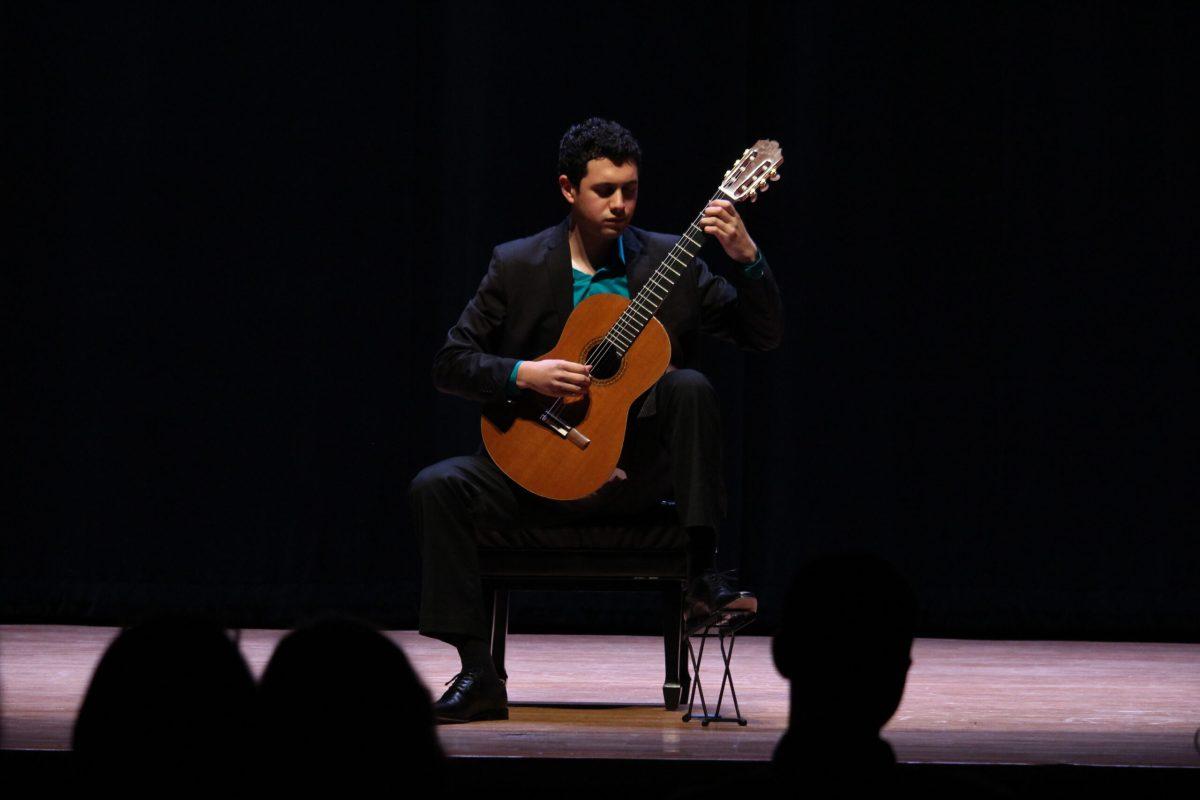A stool, footrest and an anxious audience awaited Carlos Bedoya Thursday night in Boyd Hall. The 23-year-old Rowan alumnus took his seat at center stage with his classical guitar in hand. Without saying a word, he smiled to the audience, tuned his nylon strings, closed his eyes and began his performance.
Bedoya is a 2016 graduate of Rowan with degrees in music education and guitar performance. He started his recital with Alexander Timofeev’s “Nocturne,” arranged by Bedoya himself. The tune, sounding soft and dreamlike, appeared to take Bedoya to a world of his own.
As Bedoya finished his song and placed his hand on the guitar strings to silence them, the audience’s applause seemed to bring him out of his dreamlike trance and back into Boyd Recital Hall.
Along with performing guitar, Bedoya teaches musical performance, including at Old Town Music and After School Music, while also privately teaching classical guitar. He also teaches choir.
Next in the program came Johann Sebastian Bach’s “Violin Sonata No. 3” as transcribed for guitar by Manuel Barrueco. The song is performed in four parts: I. “Adagio,” II. “Fuga,” III. “Largo,” and IV. “Allegro assai.” The “Fuga” is considered the musical climax of the piece and Bedoya’s favorite to perform.
“The Fuga is the culmination of counterpoint,” Bedoya said. “Counterpoint is when more than one melodic line is interacting with another one. Some of it has to do with the life of Bach. For example, the second part ends with how he lost his wife —they divorced— and this is the continuation of that.”
This background knowledge of Bach and his life informs Bedoya’s performances and connects him to the work.
Bedoya’s fourth and fifth songs, “Introduction et Caprice” by Giulio Regondi and “Etude No. 7” by Heitor Villa-Lobos, perfectly demonstrated his technique, dexterity and speed at playing. The former took Bedoya off again to a world of his own, containing only him and his guitar, with quick, complex runs and scales that received thunderous applause. The latter piece took the audience to a darker world full of undulating crescendos of volume and speed.
His final piece, Sergio Assad’s “Aquarelle (I. Divertimento),” seemed to be Bedoya’s most skillful performance. Soft and brisk chords provided a light and entertaining ending to Bedoya’s recital.
Audience member Kathleen Mayes, who was waiting to greet Bedoya after his performance, was one of Bedoya’s former guitar performance professors.
“I set this up for Carlos,” Mayes said. “I taught him a couple of those pieces. I especially enjoyed what has happened with ‘Las Abejas’ because when we were working on it he was really having trouble bringing out that melody, [but] he killed it tonight.”
Following his main performance, Bedoya played two short encore pieces.
Aside from Bedoya himself, his guitar was also a star of the performance.
“What caught my attention with that guitar is that it’s very easy to be polyphonic with it; it’s very easy to recognize the lines,” Bedoya said. “[With] a normal guitar, you play a single note and you play another on top of it, [and] it might sound muddy. But with this one, it’s really easy to recognize note by note the polyphonics.”
For questions/comments about this story, email [email protected] or tweet @thewhitonline.

























































































































































!["Working with [Dr. Lynch] is always a learning experience for me. She is a treasure,” said Thomas. - Staff Writer / Kacie Scibilia](https://thewhitonline.com/wp-content/uploads/2025/04/choir-1-1200x694.jpg)









































